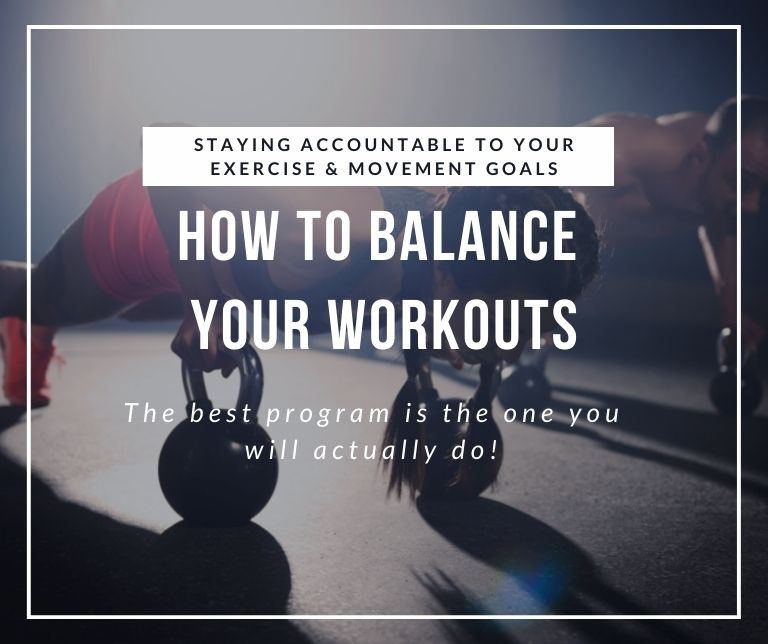Whenever I start working with someone, one of the first things we talk about is what type of movement they are already incorporating into their days.
Everybody knows they should be exercising… but nobody ever feels like they’re doing enough or the right kind, and this is often at the root of why they’re stuck in the first place.
You can probably relate: instead of asking yourself what’s possible and accessible for you with your current situation, you feel like you have to be doing the best workouts and hitting it hard every single day or it’s not worth it.
Unfortunately, this approach is just not realistic or sustainable.
There is no need to try to reinvent the wheel when it comes to your workouts. The best program is the one you will actually do, and that’s why I try to keep it very simple.
There are four key components to a balanced and sustainable workout program:
- Strength training (such as bodyweight workouts or weight lifting)
- Intentional cardio training, like HIIT workouts (short bursts of intense cardio) or LISS (Low Intensity Steady State) endurance focused training
- Active recovery (such as yoga and mobility work)
- Walking and activities of daily life
Ideally, we would see you doing at minimum two strength training sessions, two to three intentional cardio sessions, two active recovery or mobility sessions, and daily walking.
Not everyone will be ready to start at that schedule; that’s fine and we can work up to it gradually, accounting for your particular situation and constraints.
The main thing is to hit the big goals on a regular basis: moving heavy things in multiple directions, getting your heart rate up, supporting your recovery, and maintaining a healthy metabolism through regular movement.
Strength Training
Strength training — also called resistance training — is where you use your major muscle groups to move heavy things around. The two primary methods of strength training are weight lifting and bodyweight training (or calisthenics).
Like I said above, in an ideal situation, you’ll do two strength training sessions per week, with two to three days between each session.
The reason we limit strength training like this is that it’s very taxing on the muscles.
Your body needs sufficient time to recover in order for you to see the real benefits of this style of training.
Let’s take a look at the ‘super compensation model’. This is a fancy name for ‘what happens in your body after strength training’:
Before a strength training session, your strength is at a point we’ll call 1. During your session, the pressure on your muscles is going to tear your muscle fibers, which means that after your session, your strength will dip a little bit, down to, say, 0.8.
If you take a couple of days to rest and recover, your muscle fibers will repair and your strength will increase again, up to, say, 1.2. Then when you come back for your next session, the cycle starts again from that slightly stronger point.
The critical part of this equation is the rest between the sessions.
If you’re pushing yourself every day because you feel like you always have to be working, you’re actually doing yourself a disservice. You’re just going to plateau — you won’t get stronger and you’ll just feel depleted all the time.
Now, sometimes your schedule is going to mean that both your strength sessions have to happen back to back, and that’s OK as long as we know it’s coming and can program for you to train different muscle groups. If you do squats, lunges, deadlifts and hip thrusts one day, your lower body can be in recovery while your upper body trains overhead press, pushups, pullups and rows the next day.
HIIT
High intensity interval training comes in many forms: it can be a session on a spin bike or rower, sprints outside, skipping rope, or anything that really pushes your heart rate up while you’re doing it.
Regardless of the activity, the reason this is so important is that it helps strengthen your heart, improve your endurance and your aerobic capacity, and helps increase your strength too.
Ideally, I’ll alternate between strength training and HIIT sessions for my clients, with two to three HIIT sessions per week, depending on the intensity of the workouts and how much time you have available.
When you’re short on time, you can even combine them: do your strength session first, and then finish it up with a quick HIIT session. Then you’ve done two of your primary workouts for the week in one go.
LISS
Low intensity steady state cardio training can be thought of as a longer, less intense but more endurance-based exercise. So think: hiking, swimming or cycling. The kind of enjoyable activity that gets you pushing at about 50-60% of your max heart rate. I like to gauge it by ensuring I can walk/hike while still being able to carry on a conversation with a friend.
Active Recovery
On the days when you don’t have a strength or HIIT session on the calendar, ideally you would do some sort of active recovery, both so that you get the benefit of some structured movement in the day and so that you enhance your body’s ability to repair after your more intense sessions.
For most people, I program active recovery to mean yoga or mobility work, but if you’re a Type-A personality, you might feel like this ‘easy stuff’ is a waste.
After all, if you’ve got free time, shouldn’t you be doing something intense? A client said to me recently that sometimes she finds yoga a bit easy… and I had to remind her that easy is the goal!
The point of active recovery sessions is to have a guided way to get in touch with your body and to have time to notice how things are feeling.
The reason yoga and mobility work are so effective for this is that they take you out of the sagittal plane of movement — the forward facing, forward moving plane of movement — where we all spend so much time.
Whether we’re sitting at a desk, running, riding the Peloton, our bodies are not using multiple ranges of movement.
It’s critical to our health and longevity that we are also strong in the transverse plane — using the sides and back of the body, twisting, getting into different positions and moving through different ranges of motion.
Your body was designed to do more than one basic thing. If you’re ignoring all these different planes of movement and kinds of movement — pulling, pushing, overhead, twisting — those muscles will just atrophy and this can lead to injury.
Recently my daughter was doing some kid’s yoga with me and I was reminded of an excellent phrase from my kids yoga teaching days, “Yoga is very fair. What you do on one side, you have to do on the other!”
That’s a really simple reminder that the single-joint movements we do in yoga and mobility highlight if there is an imbalance in strength, if one side is overcompensating for the other, or if there are any points in the body where there’s a lot of tension or resistance.
Incorporating that information in your other training mode means that we can correct those things and improve your overall physical condition.
Walking
Walking is one of the easiest things many of us can do, and so it’s a very sustainable part of an exercise program. However, for many of us, it’s no longer part of our lifestyle. With bigger cities that require commuting, long winter months, and the occasional pandemic, using your body to get places is nowhere near as common as it used to be.
That’s a huge loss for your health.
Walking is associated with increased cardiovascular fitness, reduced risk of all lifestyle diseases, increased strength and balanced, improved bone density, and reduced total body fat.
Even 30 minutes a day can have a meaningful impact on your body (and if you’re locked down or working from home, it can do absolute wonders for your mind and mood too).
You should absolutely be able to get outside for a walk every day. If you can’t right now, let’s explore some ways you might be able to get there.
And if there’s just absolutely no way, you can still go up and down the stairs, get up from your desk and walk around your home every hour, play with your kids, run around with your dog — there are lots of incidental forms of movement that can boost your metabolism and support the rest of your training.
Remember: all this training — however you end up configuring it — is here to empower the rest of your life.
It’s not intended to be another stressful thing to cross off your to-do list, but an investment in your ability to live a satisfying, pain-free, confident life.
It should be a way to help you set a great example for your loved ones, and to make sure that no matter what stage of life you’re at, you can be in control and confident in your own body.
If you’d like to talk about building a program like this that suits your individual lifestyle, click here and let’s talk about it.




